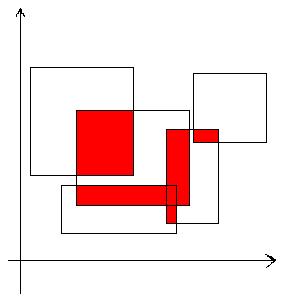hdu-1255 覆盖的面积(扫描线+线段树)
2016-03-17 00:53
302 查看
覆盖的面积
Time Limit: 10000/5000 MS (Java/Others) Memory Limit: 65536/32768 K (Java/Others)Total Submission(s): 4794 Accepted Submission(s): 2384
[align=left]Problem Description[/align]
给定平面上若干矩形,求出被这些矩形覆盖过至少两次的区域的面积.

[align=left]Input[/align]
输入数据的第一行是一个正整数T(1<=T<=100),代表测试数据的数量.每个测试数据的第一行是一个正整数N(1<=N<=1000),代表矩形的数量,然后是N行数据,每一行包含四个浮点数,代表平面上的一个矩形的左上角坐标和右下角坐标,矩形的上下边和X轴平行,左右边和Y轴平行.坐标的范围从0到100000.
注意:本题的输入数据较多,推荐使用scanf读入数据.
[align=left]Output[/align]
对于每组测试数据,请计算出被这些矩形覆盖过至少两次的区域的面积.结果保留两位小数.
[align=left]Sample Input[/align]
2
5
1 1 4 2
1 3 3 7
2 1.5 5 4.5
3.5 1.25 7.5 4
6 3 10 7
3
0 0 1 1
1 0 2 1
2 0 3 1
[align=left]Sample Output[/align]
7.63
0.00求覆盖两次或者以上的面积大小,很明显用扫描线。其实不用线段树也能做出来,但是会TLE~用线段树处理遍历的时候可以达到log(n)。这是我第一次接触这个内容,结合了kuangbin的矩形面积并模板和http://www.cppblog.com/menjitianya/archive/2016/02/25/212891.html这位大神关于线段树的讲解才终于看明白。 这里面都写得很清楚其他的就不多说了,直接上代码。
<pre name="code" class="cpp">#include <iostream>
#include <cstdio>
#include <cstring>
#include <algorithm>
using namespace std;
#define N 2020
#define lson root<<1,l,m
#define rson root<<1|1,m,r
struct Node
{
int l,r;//离散化后的区间
int c;//权值
double rl,rr;//有效区间
double once;//覆盖一次及以上的长度
double more;//覆盖两次及以上的长度
} tree[N<<2];
struct Node1
{
double x,y1,y2;
int c;
} line[N<<1];
double y
;
bool cmp(Node1 a,Node1 b)
{
return a.x<b.x;
}
void build(int root,int l,int r)
{
tree[root].l=l;
tree[root].r=r;
tree[root].rl=y[l];
tree[root].rr=y[r];
tree[root].once=0;
tree[root].more=0;
if(l+1==r) return;
int m=(l+r)>>1;
build(lson);
build(rson);
}
void pushup(int root)
{
if(tree[root].c>=2)
{
tree[root].more=tree[root].once=tree[root].rr-tree[root].rl;
}
else if(tree[root].c==1)
{
tree[root].once=tree[root].rr-tree[root].rl;
if(tree[root].l+1==tree[root].r)
{
tree[root].more=0;
}
else
{
tree[root].more=tree[root<<1].once+tree[root<<1|1].once;
}
}
else
{
if(tree[root].l+1==tree[root].r)
{
tree[root].more=tree[root].once=0;//一开始这里忘了分情况一直运行错误,把数组开大了就WA,注意叶子节点没有儿子。
}
else
{
tree[root].more=tree[root<<1].more+tree[root<<1|1].more;
tree[root].once=tree[root<<1].once+tree[root<<1|1].once;
}
}
}
void update(int root,Node1 a)
{
if(a.y1==tree[root].rl&&a.y2==tree[root].rr)
{
tree[root].c+=a.c;
pushup(root);
return;
}
if(a.y2<=tree[root<<1].rr)
{
update(root<<1,a);
}
else if(a.y1>=tree[root<<1|1].rl)
{
update(root<<1|1,a);
}
else
{
Node1 temp=a;
temp.y2=tree[root<<1].rr;
update(root<<1,temp);
temp=a;
temp.y1=tree[root<<1|1].rl;
update(root<<1|1,temp);
}
pushup(root);
}
int main()
{
int T;
int n;
double x1,y1,x2,y2;
scanf("%d",&T);
int q;
while(T--)
{
q=1;
scanf("%d",&n);
while(n--)
{
scanf("%lf %lf %lf %lf",&x1,&y1,&x2,&y2);
line[q].x=x1;
line[q].y1=y1;
line[q].y2=y2;
line[q].c=1;
y[q++]=y1;
line[q].x=x2;
line[q].y1=y1;
line[q].y2=y2;
line[q].c=-1;
y[q++]=y2;
}
sort(line+1,line+q,cmp);
sort(y+1,y+q);
build(1,1,q-1);
update(1,line[1]);
double sum=0;
for(int i=2; i<q; i++)
{
sum+=tree[1].more*(line[i].x-line[i-1].x);
update(1,line[i]);
}
printf("%.2lf\n",sum);
}
return 0;
}相关文章推荐
- 了解浏览器如何工作—渲染引擎1
- Apache 安装笔记
- <form action="./" >或者为<form action="/" >的提交路径
- 纯代码自定义cell(cell高度不一致)
- Javassist
- Express工作原理和源码分析一:创建路由
- 唯有如此,才能更强
- iOS所有常见证书,appID,Provisioning Profiles配置说明及制作图文教程
- Entity Framework Code First迁移基本面拾遗
- 数据库设计三大范式
- 无线网络的设置和使用
- ShareSDK 社会化分享 集成步骤
- 使用XML,Spring,和struts以MVC为设计模式的分布式应用程序框架
- HTML input标签的checked属性与Razor解析
- 地图 判断点在区域内
- 操作系统内存管理的一些算法
- jquery ajax级联二级下拉,jquey select级联
- ASP.NET Core和Angular 2双剑合璧
- 使用Github Windows客户端 更新 Fork 的 Repository
- Eclipse各种快捷键方式
